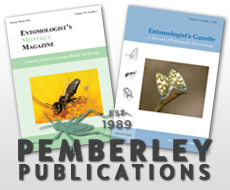Entomologist's Gazette - Vol. 67, No. 1, 2016
Published: 1/29/2016
Article Details for this issue
EDITORIAL
Page: 1
Type: Editorial
Lampyris noctiluca (Linnaeus, 1767) (Coleoptera: Lampyridae) at 1,300 m elevation in the Pyrenees
By: ADRIAN SPALDING
Page: 1
Type: Short Notes
Phyllobius vespertinus (Fabricius, 1792) (Coleoptera: Curculionidae) and other beetles in the Mersey estuary
By: PAUL F. WHITEHEAD
Page: 2
Type: Short Notes
Chionodes fumatella (Douglas, 1850) (Lepidoptera: Gelechiidae): discovery of the larva in the British Isles
By: S. D. BEAVAN & R. J. HECKFORD
Page: 3–14
Type: Paper
Synopsis:
An account is given of the larva of Chionodes fumatella (Douglas, 1850), which has
apparently not been found previously in the British Isles. In 2015 three larvae were found
amongst minute traces of silk on the surface of the moss Barbula convoluta Hedw. in Essex and
several were discovered in sand-covered silken tubes attached to the base of the moss
Brachythecium albicans (Hedw.) Schimp. in Norfolk. Both localities are in England. Mainland
European accounts are reviewed.
Further observations on Melitaea ornata Christoph, 1893 (Lepidoptera: Nymphalidae) in the Republic of Macedonia
By: PETER RUSSELL & JAMES PATEMAN
Page: 15–22
Type: Paper
Synopsis:
Further records of Melitaea ornata from the Republic of Macedonia are provided, supported
by observations of L4 and later stage larvae having red-brown heads, which separates this
species from M. phoebe, the larvae of which have black heads in every instar. Centaurea
grisebachii is reported for the first time as a larval host-plant for M. ornata.
Kessleria fasciapennella (Stainton, 1849) (Lepidoptera: Yponomeutidae): discovery of the larva in Scotland and a consideration of prior Scottish records of the adult
By: S. D. BEAVAN, R. J. HECKFORD, T. PRESCOTT, D. WATSON & M. R. YOUNG
Page: 23–46
Type: Paper
Synopsis:
An account is given of the discovery of the larva of Kessleria fasciapennella (Stainton, 1849)
amongst Parnassia palustris L. at Meall Mór, Argyll, Scotland. The larva had not been found
previously in the British Isles and this is only the second British record of this species since the
mid-nineteenth century. Unsuccessful searches for the species at three other Scottish localities
are also reported. Previous known British records are given, differences are noted between the
larval mine and larva observed in 2015 and a published account, variation in the ground colour
of the forewing is recorded and differences are given between the adults of Kessleria
fasciapennella and K. saxifragae (Stainton, 1868).
Orkney sawflies (Hymenoptera): a rich island fauna?
By: J. A. STOCKAN
Page: 47–50
Type: Paper
Synopsis:
This paper details recent records and provides an updated list of the species of sawflies
found on the Orkney Islands.
Sex pheromones as isolating mechanisms in two closely related Illiberis species – I. (Primilliberis) rotundata Jordan, 1907, and I. (P.) pruni Dyar, 1905 (Lepidoptera: Zygaenidae, Procridinae)
By: MITKO A. SUBCHEV, KONSTANTIN A. EFETOV, TEODORA B. TOSHOVA & CHIHARU KOSHIO
Page: 51–57
Type: Paper
Synopsis:
Illiberis (Primilliberis) rotundata Jordan, 1907, and I. (P.) pruni Dyar, 1905, are closely related
species that occur sympatrically in Japan, China and Korea. Two pheromone compounds,
active in the attraction of the conspecific males in the field, were identified in extracts of I.
rotundata female sex pheromone glands: (2R)-butyl (7Z)-dodecenoate and (2R)-butyl (9Z)-
tetradecenoate. The same compounds were also found to attract I. pruni males in the field.
Besides occurring in the same geographic regions and the same biotopes, viz. orchards, the two
species also have overlapping daily and seasonal flight periods, so the attraction of the males of
one of these two species by the females of the other species is very possible. However, our field
experiments showed that while the best ratio of (2R)-butyl (7Z)-dodecenoate and (2R)-butyl
(9Z)-tetradecenoate for attraction of I. rotundata males was 30 : 100 and 50 : 100, the males of
I. pruni were attracted mostly by the 100 : 10 mixture of these two compounds. Thus, the main
isolating factor preventing cross attraction of the I. rotundata males to I. pruni females and vice
versa seems to be the different ratio of the sex pheromone compounds shared by the two species
with (2R)-butyl (7Z)-dodecenoate predominating in the case of I pruni and (2R)-butyl (9Z)-
tetradecenoate in that of I. rotundata.
BOOK REVIEW Britain’s Hoverflies: a field guide, by Roger Morris & Stuart Ball
By: ALAN STUBBS
Page: 58
Type: Book Review
Two new species of Chrysartona Swinhoe, 1892 (Lepidoptera: Zygaenidae, Procridinae) from northern Thailand and central Myanmar (Burma)
By: BERNARD MOLLET
Page: 59–64
Type: Paper
Synopsis:
Chrysartona (Chrysartona) murzini sp. nov. from Thailand and Chrysartona (Chrysartona)
sylvianae sp. nov. from Myanmar are described. A key to the males of the subgenus Chrysartona
is provided.
BOOK REVIEW Distribution Atlas of European Butterflies and Skippers, by Otakar Kudrna, Josef Pennerstorfer & Kristian Lux
By: R. L. H. DENNIS
Page: 65-68
Type: Book Review
BOOK REVIEW Lepidoptera of Continental Portugal, a fully revised list, by M. F. V. Corley
By: DAVID AGASSIZ
Page: 69-70
Type: Book Review
BOOK REVIEW The Butterflies of Britain & Ireland (new revised edition), by Jeremy Thomas & Richard Lewington
By: JOHN TENNENT
Page: 71-72
Type: Book Review
BOOK REVIEW Butterflies of the World, by Adrian Hoskins
By: P. B. HARDY
Page: 73-74
Type: Book Review



